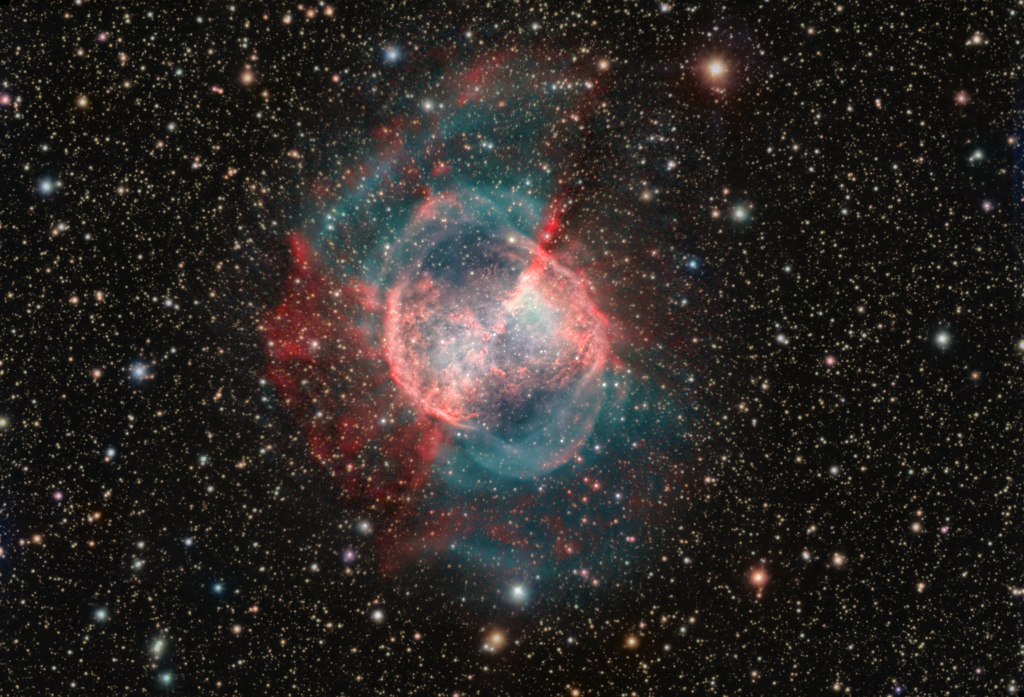Nombre total de pages vues
08/10/2024
ASTRONOMIE - Comment voir la comète Tsuchinshan-ATLAS ?
LES NUAGES DIEUX DU CIEL - Cirrus rouges
ASTRONOMY - Annular Eclipse over Patagonia
2024 October 8
Image Credit & Copyright: Alexis Trigo
Explanation: Can you find the Sun? OK, but can you explain why there’s a big dark spot in the center? The spot is the Moon, and the impressive alignment shown, where the Moon lines up inside the Sun, is called an annular solar eclipse. Such an eclipse occurred just last week and was visible from a thin swath mostly in Earth's southern hemisphere. The featured image was captured from Patagonia, Chile. When the Moon is significantly closer to the Earth and it aligns with the Sun, a total solar eclipse is then visible from parts of the Earth. Annular eclipses are slightly more common than total eclipses, but as the Moon moves slowly away from the Earth, before a billion more years, the Moon's orbit will no longer bring it close enough for a total solar eclipse to be seen from anywhere on Earth.
07/10/2024
SANTé/MEDECINE - ALIMENTATION - NUTRIMENTS - Les prébiotiques. Des aliments entretiennent la flore bactérienne
ASTRONOMY - The Long Tails Comet Tsuchinshan-ATLAS
2024 October 7
Image Credit & Copyright: Jose Santivañez Mueras
Explanation: A bright comet is moving into the evening skies. C/2023 A3 (Tsuchinshan–ATLAS) has brightened and even though it is now easily visible to the unaided eye, it is so near to the Sun that it is still difficult to see. Pictured, Comet Tsuchinshan–ATLAS was captured just before sunrise from an Andes Mountain in Peru. Braving cold weather, this unusually high perch gave the astrophotographer such a low eastern horizon that the comet was obvious in the pre-dawn sky. Visible in the featured image is not only an impressively long dust tail extending over many degrees, but an impressively long and blue ion tail, too. This month, as the comet moves out from the Sun and passes the Earth, evening observers should be able to see the huge dirty ice ball toward the west just after sunset.
06/10/2024
ASTRONOMY - The Magnificent Tail of Comet McNaught
Image Credit & Copyright: Robert H. McNaught
Explanation: Comet McNaught, the Great Comet of 2007, grew a spectacularly long and filamentary tail. The magnificent tail spread across the sky and was visible for several days to Southern Hemisphere observers just after sunset. The amazing ion tail showed its greatest extent on long-duration, wide-angle camera exposures. During some times, just the tail itself was visible just above the horizon for many northern observers as well. Comet C/2006 P1 (McNaught), estimated to have attained a peak brightness of magnitude -5 (minus five), was caught by the comet's discoverer in the featured image just after sunset in January 2007 from Siding Spring Observatory in Australia. Comet McNaught, the brightest comet in decades, then faded as it moved further into southern skies and away from the Sun and Earth. Over the next month, Comet Tsuchinshan–ATLAS, a candidate for the Great Comet of 2024, should display its most spectacular tails visible from the Earth.
05/10/2024
INVENTIONS A L'HORIZON 2050 - La voiture à hydrogène plus forte que l'électrique ?
ASTRONOMY - M27: Not a Comet
2024 October 5
Image Credit & Copyright: Francesco Sferlazza, Franco Sgueglia
Explanation: While hunting for comets in the skies above 18th century France, astronomer Charles Messier diligently kept a list of the things encountered during his telescopic expeditions that were definitely not comets. This is number 27 on his now famous not-a-comet list. In fact, 21st century astronomers would identify it as a planetary nebula, but it's not a planet either, even though it may appear round and planet-like in a small telescope. Messier 27 (M27) is an excellent example of a gaseous emission nebula created as a sun-like star runs out of nuclear fuel in its core. The nebula forms as the star's outer layers are expelled into space, with a visible glow generated by atoms excited by the dying star's intense but invisible ultraviolet light. Known by the popular name of the Dumbbell Nebula, the beautifully symmetric interstellar gas cloud is over 2.5 light-years across and about 1,200 light-years away in the constellation Vulpecula. This impressive color image highlights details within the well-studied central region and fainter, seldom imaged features in the nebula's outer halo.
04/10/2024
LES NUAGESDIEUX DU CIEL - Altocumulus stratiformis opacus undulatus virga
ASTRONOMIE - La comète Tsuchinshan-ATLAS approche
SANTé/MEDECINE - Procédé révolutionnaire dans la lutte contre le cancer - 2/6 : Une découverte qui change tout
Jusqu’à présent, la lutte contre le cancer reposait principalement sur la chimiothérapie, la radiothérapie ou la chirurgie. Ces traitements,...

-
2022 September 26 All the Water on Planet Earth Illustration Credit: Jack Cook, Adam Nieman, Woods Hole Oceanographic Institution ; Data ...
-
La majorité des grêlons qui tombent sous les orages et les averses ne pèsent que quelques grammes. Mais il y a quelques années, c'est un...











